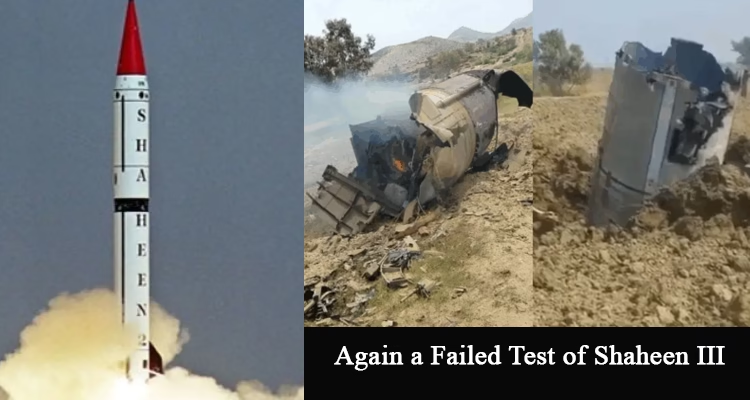
News Desk: As details continue to emerge following the recent failure of Pakistan’s long-range Shaheen-III ballistic missile, defense analysts are pointing to a series of technical lapses that may have led to the embarrassing crash earlier this week. The nuclear-capable missile, believed to have a range of 2,750 km, veered off course during testing and crashed into a remote area in Balochistan’s Dera Bugti district — narrowly avoiding a civilian tragedy.
Though the incident reportedly took place on July 22 or 23, the Pakistan military has remained tight-lipped. However, evidence gathered from open-source intelligence, eyewitness accounts, and local reports suggests a serious malfunction mid-flight, most likely stemming from one or more of the following reasons:
Possible Causes of Failure
-
Guidance System Malfunction: Analysts believe the missile may have suffered from a navigation error, possibly due to a software fault or gyro misalignment, resulting in loss of trajectory control.
-
Propulsion or Stage Separation Issues: A failure during engine ignition or booster separation could have destabilized the flight, leading to a crash.
-
Structural Instability: The missile’s frame may have experienced aerodynamic stress beyond its tolerance limits, causing it to break apart or descend prematurely.
-
Inadequate Ground Simulations: Pakistan’s missile program has long faced criticism for insufficient stress-testing protocols, which could explain recurring issues in flight validation.
The Incident: Missile Crashes Near Civilian Area
The Shaheen-III was launched from the Rakhshani testing range in Dera Ghazi Khan. Within minutes, it deviated from its intended path and crashed into the Matt area of Dera Bugti, just 500 meters from the Loop Sehrani Levies Station. No casualties were reported, but residents described hearing a loud explosion followed by tremors and shockwaves that reached neighboring villages.
Villagers initially believed an earthquake had struck. However, military vehicles cordoned off the area within hours, and debris resembling missile fragments was quickly recovered. Official channels have yet to acknowledge the incident, and there was a brief internet blackout in the region immediately after.
Strategic and Political Fallout
This marks at least the third known failure of the Shaheen-III missile in the last few years. The repeated misfires are raising serious doubts about the credibility of Pakistan’s strategic deterrence and its long-range missile capabilities.
Experts argue that:
-
Confidence in Pakistan’s second-strike capability is being eroded.
-
The proximity of the crash to nuclear facilities in Dera Ghazi Khan could have led to a catastrophic accident.
-
Balochistan’s continued use as a missile test zone is fueling resentment among local populations, who see these exercises as reckless and hazardous.
A defense analyst in New Delhi noted, “Pakistan’s efforts to modernize its missile arsenal are backfiring. Frequent failures of Shaheen-III and Ababeel indicate not only technical flaws but a worrying lack of system redundancy and quality control.”
Local Reaction: “We Are Not a Testing Ground”
The incident has reignited protests in Balochistan, with activists and tribal leaders condemning Islamabad for endangering lives. “The people of Balochistan are not guinea pigs for failed missile trials,” said a spokesperson from a regional rights group.
Environmentalists have also warned about the long-term impact of missile fuel and debris on the fragile desert ecology of the region.
Information Blackout and Media Control
Despite the scale of the mishap, Pakistani mainstream media has largely avoided covering the issue, reportedly under military advisories. Independent reports suggest that local journalists were warned against photographing the crash site or speaking to witnesses.
Meanwhile, satellite images and OSINT (Open-Source Intelligence) investigators have been able to confirm unusual activity and scorched terrain consistent with a missile crash in the reported area.
The failed test of the Shaheen-III is more than a technical error — it’s a significant strategic and political embarrassment for Pakistan. The silence from Islamabad only adds to the growing skepticism over the nation’s defense preparedness. As international observers watch closely, questions remain: How secure and effective is Pakistan’s missile program, and at what cost to its own people?



